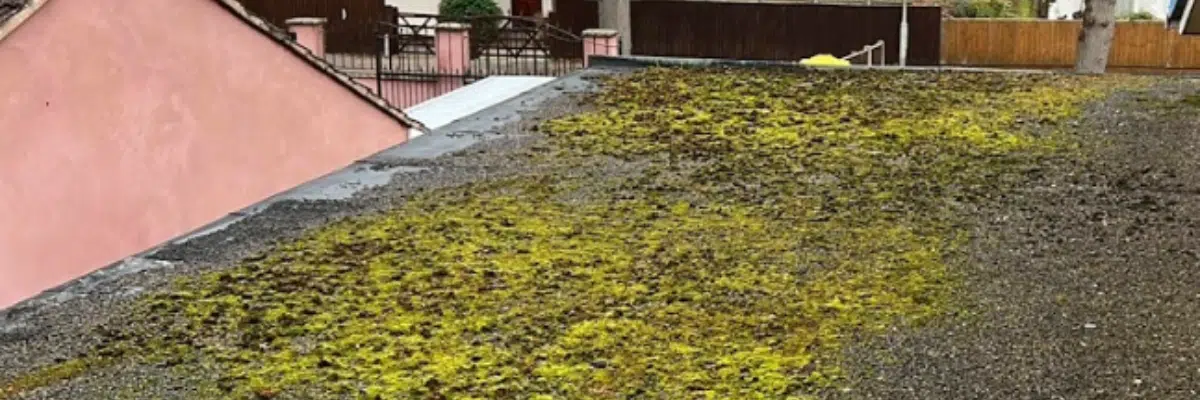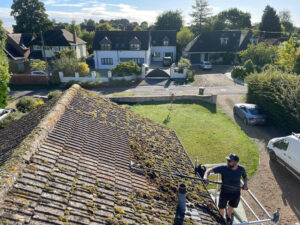Maintaining a roof is an essential aspect of homeownership that is often overlooked until issues arise. One of the most common problems that homeowners face is the accumulation of moss on their roofs. While moss might seem harmless or even add a rustic charm to a home’s exterior, it can lead to significant structural damage over time. Understanding the role of moss removal in roof maintenance can help homeowners prevent costly repairs and extend the lifespan of their roofs.
Understanding Moss Growth on Roofs
Moss thrives in damp, shaded environments, making roofs an ideal location for its growth. It typically appears in areas where moisture is retained, such as on the north-facing side of a roof or beneath overhanging trees. Moss spores travel through the air and attach themselves to surfaces where they can take root and spread. Unlike algae, which may simply cause unsightly discoloration, moss can retain water, leading to persistent dampness on the roof.
The presence of moss on a roof is often an indication of underlying moisture issues. Factors such as poor drainage, inadequate sunlight, and overhanging branches can contribute to its spread. Left untreated, moss can accelerate roof deterioration, leading to more significant problems such as leaks and structural instability.

The Impact of Moss on Roof Longevity
Moss may seem like a minor inconvenience, but its effects on a roof can be severe. The biggest concern is that moss holds moisture against roofing materials, preventing proper drying after rainfall. This prolonged dampness can weaken shingles, causing them to curl, crack, or break. Once the protective outer layer of shingles is compromised, water can seep into the underlying structure, leading to leaks and wood rot.
In colder climates, moss exacerbates damage through freeze-thaw cycles. When water trapped in the moss freezes, it expands, putting pressure on shingles and creating cracks. Over time, these cracks can widen, allowing even more moisture to penetrate the roof’s surface. If left unaddressed, the damage can extend to the attic, insulation, and even the interior of the home.
Moss also contributes to the deterioration of roofing materials by trapping debris such as leaves and dirt. This buildup can create a breeding ground for mold and mildew, further weakening the roof’s integrity. Additionally, moss can lift shingles as it grows, making the roof more vulnerable to wind damage.
Preventing Moss Growth
The key to effective moss control is prevention. Regular roof maintenance can help homeowners identify and address conditions that promote moss growth. Keeping the roof free from debris, ensuring proper drainage, and trimming overhanging branches are all essential steps in reducing moisture retention.
Ensuring that the roof receives adequate sunlight is another crucial factor in moss prevention. Shaded areas tend to remain damp longer, creating an ideal environment for moss to thrive. By trimming tree branches and clearing any obstructions that block sunlight, homeowners can reduce the likelihood of moss taking hold.
Another preventive measure is the installation of zinc or copper strips along the ridge of the roof. When rainwater washes over these strips, small amounts of metal are released, creating an environment that inhibits moss growth. While this method does not eliminate existing moss, it can significantly slow down new growth.
Safe and Effective Moss Removal
For roofs already affected by moss, removal is necessary to prevent further damage. However, improper cleaning methods can cause additional harm to the roof. Using a pressure washer, for example, can strip away protective granules from shingles and force water underneath them, leading to leaks.
 A gentler approach involves using specialized moss removal solutions designed to break down moss without damaging roofing materials. These solutions are typically applied with a sprayer and allowed to sit before gently rinsing or brushing the moss away. Many commercial moss removal products contain biodegradable ingredients that are safe for the environment while effectively eliminating moss growth.
A gentler approach involves using specialized moss removal solutions designed to break down moss without damaging roofing materials. These solutions are typically applied with a sprayer and allowed to sit before gently rinsing or brushing the moss away. Many commercial moss removal products contain biodegradable ingredients that are safe for the environment while effectively eliminating moss growth.
For homeowners seeking a more natural solution, a mixture of water and household vinegar or mild dish soap can be applied to the affected areas. However, it is essential to avoid using harsh chemicals such as bleach, as they can damage shingles and harm surrounding vegetation.
In cases where moss has spread extensively, professional roof cleaning services may be necessary. Roofing experts have the tools and experience to safely remove moss while ensuring that the roof remains intact. They can also assess whether additional repairs are needed to address any damage caused by prolonged moss growth.
Long-Term Roof Maintenance Strategies
Beyond moss removal, routine roof maintenance is crucial in extending the life of a roof and preventing future issues. Regular inspections allow homeowners to detect early signs of wear and take corrective action before minor problems escalate.
Cleaning gutters regularly helps prevent water buildup, which can contribute to moss growth. Clogged gutters can lead to overflowing water that seeps under shingles, creating a damp environment that encourages moss and mold. Ensuring that downspouts are clear and directing water away from the foundation also helps maintain overall roof health.
Replacing damaged or missing shingles promptly is another essential maintenance practice. When shingles are in good condition, they provide a strong protective barrier against moisture. Any compromised areas should be repaired to prevent water infiltration and the subsequent growth of moss.
Investing in professional roof inspections at least once a year can help homeowners stay ahead of potential problems. Roofing professionals can identify vulnerabilities, recommend preventative measures, and provide expert cleaning services to keep the roof in optimal condition.